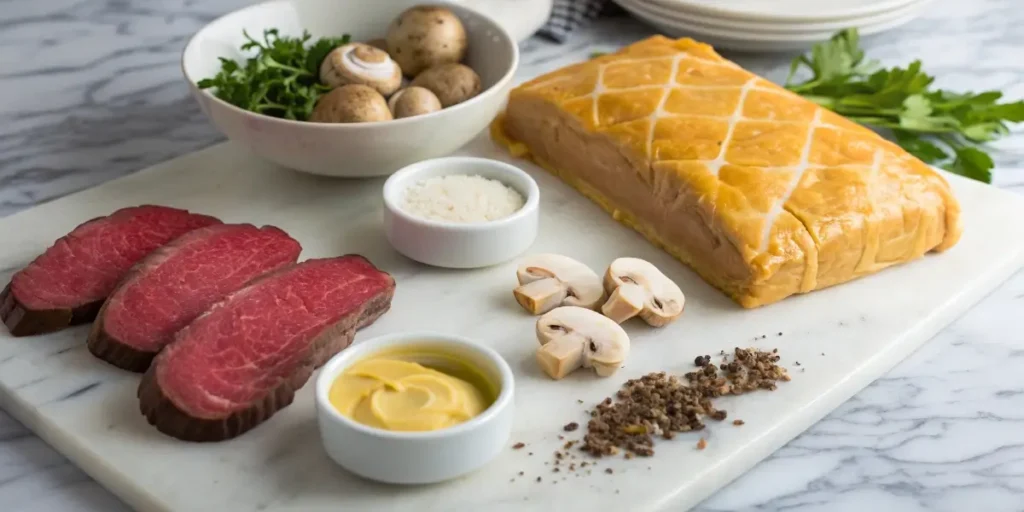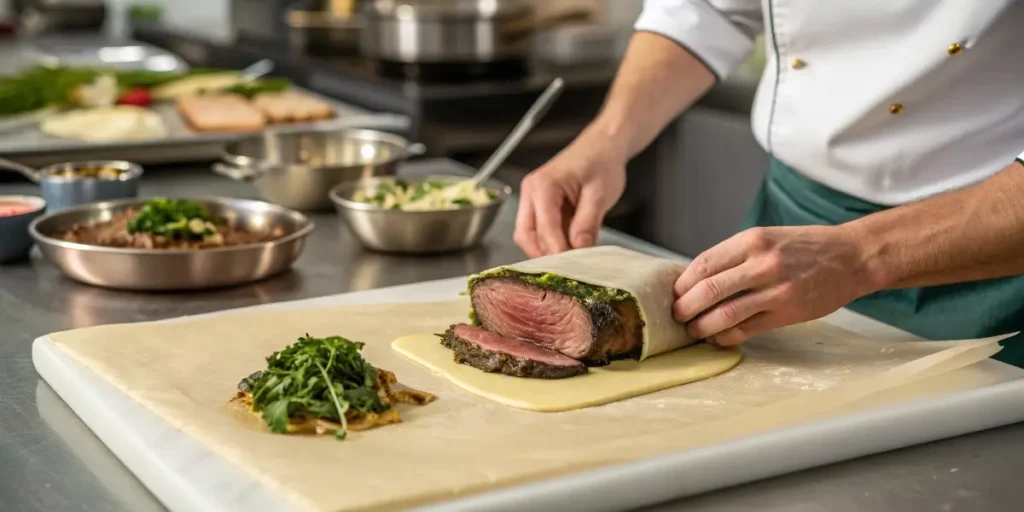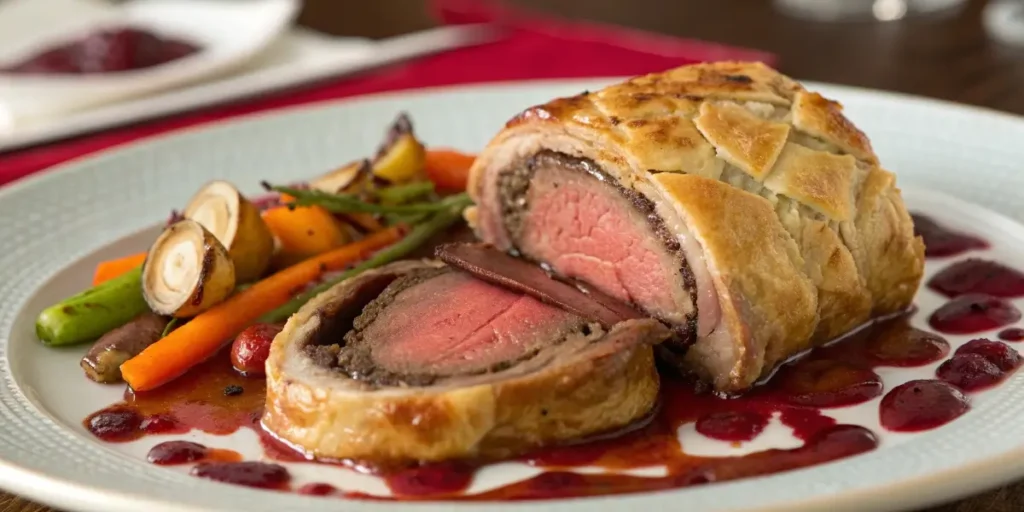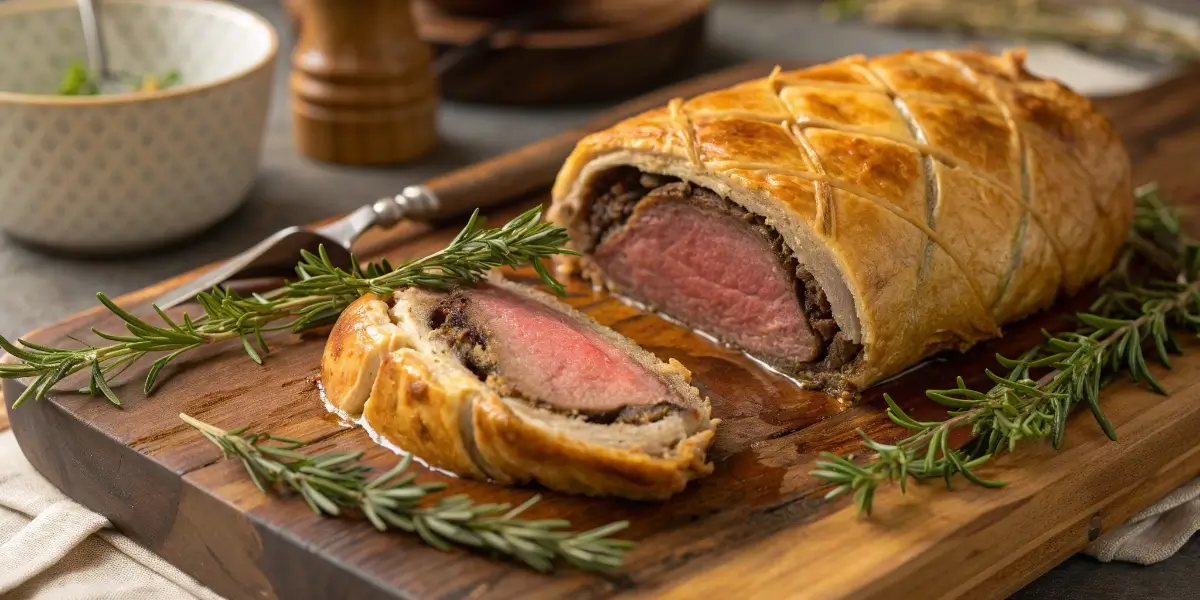Gordon Ramsay Beef Wellington Recipe – A Culinary Masterpiece You Can Recreate at Home
Gordon Ramsay Beef Wellington recipe stands as one of the most celebrated dishes in modern fine dining. With its tender center-cut beef fillet, rich mushroom duxelles, and perfectly crisp puff pastry, this dish has become synonymous with precision and perfection. Ramsay turned a traditional British classic into a global phenomenon, inspiring home cooks and professionals alike.
In this article, you’ll discover the secrets behind this iconic meal — from mastering each step of preparation to learning how to achieve that signature golden crust. Ready to cook like a Michelin-starred chef? Let’s dive in.
Looking for inspiration? Try our delicious smoked salmon brine recipe for another restaurant-quality dish made simple.
Table of Contents
The Legacy of Gordon Ramsay’s Beef Wellington
How Gordon Ramsay’s Beef Wellington Become World-Famous
When it comes to culinary prestige, few dishes rival Gordon Ramsay’s Beef Wellington. Through his acclaimed TV shows like Hell’s Kitchen and MasterChef, Ramsay transformed this British staple into an international icon. Contestants often view it as the ultimate test of culinary skill — a delicate balance of flavor, texture, and timing. The dish reflects Ramsay’s dedication to discipline, precision, and creativity in the kitchen.
Beyond television, this dish graces the menus of Ramsay’s Michelin-starred restaurants across the globe. Each version adheres to the same meticulous standards: seared beef tenderloin encased in mushroom duxelles and prosciutto, all wrapped in flaky puff pastry. This signature combination of luxury and technique is what made Beef Wellington a symbol of gourmet excellence.
Why This Recipe Became a Signature Dish Across His Restaurants
The Beef Wellington encapsulates everything Gordon Ramsay stands for — sophistication, craftsmanship, and unforgettable taste. Its appeal lies in its simplicity of ingredients paired with the complexity of execution. Every element, from the duxelles to the pastry, demands attention to detail.
At Ramsay’s restaurants, Beef Wellington isn’t just a meal; it’s an experience. The dish’s golden exterior and tender interior tell a story of culinary passion and precision. It also represents Ramsay’s British heritage while showcasing French-inspired finesse — a perfect fusion that defines his cooking style.
Don’t miss our steak seasoning recipe to elevate your next steak night with gourmet flavor.
What Makes Gordon Ramsay’s Beef Wellington Recipe Unique
The Signature Ingredients That Elevate Flavor
What truly sets Gordon Ramsay’s Beef Wellington apart is his attention to ingredient quality. Ramsay insists on using a center-cut beef tenderloin (also known as filet mignon), which delivers unmatched tenderness and juiciness. The beef is seared to lock in its natural flavors before being coated in a finely chopped mushroom duxelles — a mix of mushrooms, shallots, and herbs sautéed until nearly dry.
To enhance the umami profile, Ramsay adds a thin layer of Dijon mustard to the seared beef, giving it a sharp yet balanced tang. He then wraps the beef and mushroom mixture in prosciutto before encasing it in a buttery puff pastry. The prosciutto serves a vital purpose: it acts as a moisture barrier, keeping the pastry crisp and preventing sogginess during baking.
Learn more about layering flavors and textures in your meals by checking out our braised boneless short ribs recipe, another restaurant-worthy dish that relies on slow cooking perfection.
Gordon Ramsay’s Beef Wellington Professional Techniques for Perfect Texture
Precision and timing are key to replicating Ramsay’s results. His method involves chilling the wrapped Wellington before baking — a crucial step that allows the pastry to hold its shape and prevents butter from leaking out during cooking. He also recommends using a meat thermometer to ensure the beef remains medium-rare (around 125°F to 130°F before resting).
Another hallmark of Ramsay’s technique is his use of egg yolk for glazing instead of a full egg wash. This gives the pastry a deeper golden hue and that signature restaurant-style sheen. The result? A Beef Wellington that’s crispy on the outside, tender in the middle, and bursting with layered flavor in every bite.
Don’t miss our pan-seared lamb chops recipe to practice similar searing and resting techniques that Ramsay swears by for perfect meat texture.
Essential Ingredients for Authentic Gordon Ramsay’s Beef Wellington

High-Quality Beef Fillet and Mushroom Duxelles
At the heart of every perfect Gordon Ramsay’s Beef Wellington lies the beef fillet. Ramsay always chooses a center-cut filet mignon, known for its even shape and buttery texture. This cut ensures that the beef cooks uniformly, achieving that coveted pink center surrounded by crisp, golden pastry. Before wrapping, Ramsay sears the beef fillet quickly on high heat to seal in juices and build that savory crust essential for flavor depth.
Next comes the mushroom duxelles — a finely chopped blend of mushrooms, shallots, garlic, thyme, and butter cooked until it forms a paste-like consistency. The duxelles are the soul of the dish, infusing the beef with rich umami tones while absorbing excess moisture. Ramsay emphasizes cooking the mixture long enough to drive off all liquid; this keeps the pastry flaky and prevents sogginess.
For added depth, many home chefs add a splash of brandy during the reduction, which complements the earthy mushrooms beautifully. Learn more about crafting rich, savory sauces by checking out our homemade chicken and gravy recipe — a comfort classic with gourmet flair.
Puff Pastry and Prosciutto – The Layers of Perfection
The artistry of Gordon Ramsay’s Beef Wellington lies in the wrapping process. He begins with a thin layer of prosciutto, which provides a salty contrast to the sweet duxelles while acting as a barrier to trap moisture. This delicate layer keeps the puff pastry crisp and golden throughout baking.
Then comes the puff pastry — the final shield of buttery luxury. Ramsay recommends using all-butter puff pastry for best results, as it produces flaky layers and that irresistible crunch when baked. Before wrapping, he chills the pastry to ensure it stays firm and bakes evenly. The surface is brushed with an egg yolk glaze to achieve that deep golden-brown finish that’s become his trademark.
Want to practice pastry perfection? Check out our puff pastry mini quiche recipe to master rolling, filling, and baking flaky pastry layers.
Step-by-Step Guide – How to Make Gordon Ramsay’s Beef Wellington
Preparing the Beef and Mushroom Duxelles
To create the perfect Gordon Ramsay’s Beef Wellington, preparation is everything. Begin by selecting a center-cut beef tenderloin, about 2 pounds, and season it generously with salt and pepper. Heat olive oil in a heavy skillet until smoking hot, then sear the beef on all sides for about 1–2 minutes per side until beautifully browned. Remove the beef, brush it with Dijon mustard, and set it aside to cool. The mustard adds a sharp tang that balances the richness of the beef and pastry.
Next, prepare the mushroom duxelles. Finely chop cremini or button mushrooms and sauté them with shallots, garlic, thyme, and butter until all moisture evaporates. This mixture should form a thick, flavorful paste. Allow the duxelles to cool before layering — this ensures your pastry stays crisp.
Once cooled, lay a sheet of plastic wrap on a flat surface. Arrange slices of prosciutto slightly overlapping on the wrap, spread the mushroom duxelles evenly over it, and place the seared beef on top. Carefully roll it up into a tight log using the plastic wrap. Chill the wrapped beef in the refrigerator for at least 20–30 minutes. This step helps maintain shape and makes wrapping easier later.
For another comfort dish using similar searing and resting techniques, check out our Italian beef crock pot recipe.

Wrapping, Chilling, and Baking the Wellington to Perfection
Now comes the most crucial step — wrapping with puff pastry. Roll out a sheet of chilled puff pastry on a floured surface. Remove the plastic wrap from the beef roll and place it in the center of the pastry. Fold the pastry edges over the beef, trimming any excess, and seal the seams tightly to prevent leakage during baking. Brush the entire surface with egg yolk for a glossy finish.
Before baking, chill the wrapped Wellington again for 15–20 minutes to firm up the pastry. This step ensures that the butter in the pastry remains cold, creating those signature flaky layers. Preheat your oven to 400°F (200°C) and bake for 35–40 minutes, or until the pastry turns golden brown and the internal temperature of the beef reaches 125°F (medium-rare). Let the Wellington rest for 10 minutes before slicing.
For a perfectly balanced meal, pair it with a rich side dish like our creamy succotash recipe, which adds sweetness and texture contrast.
Tips and Tricks from Gordon Ramsay for Perfect Results
Avoiding Common Mistakes in Beef Wellington Preparation
Even experienced cooks can make mistakes with a dish as technical as Gordon Ramsay’s Beef Wellington. One of the most common errors is not chilling the components. Ramsay emphasizes that both the beef and pastry should be cold before baking — warm dough will melt the butter, resulting in soggy pastry instead of those signature flaky layers.
Another frequent issue is overcooking the beef. Because the Wellington continues to cook as it rests, Ramsay advises pulling it from the oven when the internal temperature hits 125°F (medium-rare). After resting, it will rise to about 130–135°F, ensuring a perfectly tender pink center.
You should also avoid overstuffing the Wellington with duxelles or using wet mushrooms. Excess moisture turns the pastry soggy. Always cook down your mushroom mixture until it’s nearly dry, and allow all fillings to cool completely before assembly.
Discover great ideas like our smoked chuck roast recipe to practice balancing moisture and flavor during long cooking processes.
Ramsay’s Pro Tips for Timing, Temperature, and Plating
Timing is everything when creating the perfect Beef Wellington. Ramsay’s top secret? Staging. He preps each component separately — the duxelles, the seared beef, and the pastry — then assembles everything at the last moment for freshness and precision. This method ensures that each element retains its intended texture and temperature.
For presentation, Ramsay recommends slicing the Wellington with a sharp, serrated knife to prevent the pastry from crumbling. Always wipe the blade between cuts for a clean, restaurant-style look.
And for a flavorful twist, try pairing this dish with our garlic parmesan chicken pasta, a creamy, indulgent side dish that complements the boldness of the Wellington perfectly.
Pairings and Sides for Gordon Ramsay’s Beef Wellington
Classic Sides – Roasted Vegetables
No Gordon Ramsay Beef Wellington recipe is complete without sides that complement its richness. Ramsay often serves this dish with roasted root vegetables — think carrots, parsnips, and fingerling potatoes — lightly seasoned with olive oil, salt, and herbs. Their natural sweetness enhances the savory, buttery notes of the Wellington.
For more comfort-style inspiration, don’t miss our delicious carnivore diet recipes that highlight rich, meaty flavors similar to Wellington’s indulgence.

Modern Twists – Light Salads
For those who prefer lighter accompaniments, Ramsay’s Beef Wellington pairs beautifully with crisp salads. A baby arugula salad with shaved Parmesan and lemon vinaigrette adds freshness that cuts through the richness of the dish. Alternatively, a roasted beet and goat cheese salad provides earthy sweetness and a creamy contrast.
Check out our goat cheese recipes to add more gourmet flair to your sides, or learn how to perfect classic starch pairings with our parmesan smashed potatoes.
Behind the Chef – Gordon Ramsay’s Passion for Perfection
What Drives Ramsay’s Culinary Excellence
Gordon Ramsay’s relentless pursuit of perfection is what makes his cooking — and his Beef Wellington — world-class. Born in Scotland and raised in England, Ramsay’s early years were marked by discipline and determination. He trained under iconic chefs like Marco Pierre White and Guy Savoy, developing the precision and intensity that now define his kitchen style.
Ramsay’s philosophy revolves around three principles: quality, consistency, and passion. He believes every dish, no matter how simple, should showcase craftsmanship. This mindset explains why his Beef Wellington is so revered; it’s a symphony of technique and flavor executed flawlessly. For Ramsay, there are no shortcuts — only mastery through repetition and respect for ingredients.
His drive extends beyond cooking; he’s built a culinary empire of Michelin-starred restaurants and hit TV shows, always pushing chefs to reach higher standards. His demand for excellence has shaped a generation of cooks who carry his meticulous approach worldwide.
To discover a comfort classic that balances technique and simplicity, check out our smothered chicken recipe.
How His Television Presence Changed Modern Cooking
Gordon Ramsay’s fiery personality and no-nonsense approach transformed how audiences view professional cooking. Through Hell’s Kitchen, MasterChef, and Kitchen Nightmares, he turned culinary precision into entertainment. Yet, behind the drama, Ramsay’s goal was to educate and inspire. He made fine dining accessible, encouraging home cooks to attempt dishes once reserved for elite restaurants — including his legendary Beef Wellington.
His television influence didn’t just raise the bar for cooking standards — it made culinary education mainstream. Ramsay’s insistence on perfection taught millions the value of patience, proper seasoning, and presentation. In doing so, he built a bridge between Michelin-star artistry and home kitchens.
For more recipes inspired by restaurant-quality techniques, don’t miss our delicious milk street recipes, which showcase international flavors with everyday ingredients.
Conclusion – Bringing Gordon Ramsay’s Beef Wellington to Your Kitchen
Why Every Home Cook Should Try This Recipe
Recreating Gordon Ramsay’s Beef Wellington at home isn’t just about preparing a meal — it’s about mastering technique, patience, and precision. This dish teaches every cook how to layer flavors, control temperature, and elevate presentation. While it may seem intimidating at first, the reward of cutting through that golden pastry to reveal a perfectly pink center makes every minute worth it.
Even without a Michelin kitchen, you can still achieve professional results by following Ramsay’s steps: use quality ingredients, keep everything cold, and never rush the process. It’s the perfect dish for holidays, special occasions, or any time you want to impress your guests.
If you love cooking show-worthy dishes, check out our delicious Mexican cornbread casserole for a hearty, flavorful dinner idea that’s just as crowd-pleasing.
FAQs
What makes Gordon Ramsay’s recipe unique?
Gordon Ramsay’s Beef Wellington stands apart because of his meticulous layering technique and emphasis on ingredient quality. He combines tender beef fillet, earthy mushroom duxelles, salty prosciutto, and buttery puff pastry into a perfectly balanced dish. Ramsay’s use of Dijon mustard between the beef and mushrooms adds a sharp, tangy flavor that enhances the beef’s richness. His chilling technique before baking ensures that every Wellington comes out crisp and evenly cooked.
Who is the #1 chef in the world?
Gordon Ramsay consistently ranks among the world’s top chefs, but the #1 spot is often shared among culinary legends like Alain Ducasse, Pierre Gagnaire, and Massimo Bottura. Ramsay’s global empire, which includes over 30 restaurants and multiple Michelin stars, firmly places him in the elite circle of top chefs worldwide. His ability to combine British tradition with French precision sets him apart as one of the most influential culinary figures of our time.
What is Gordon Ramsay’s most famous dish?
While Gordon Ramsay is known for numerous dishes, his Beef Wellington remains his most iconic creation. It’s a dish that tests skill, timing, and patience — all hallmarks of Ramsay’s cooking style. However, other popular dishes include his scrambled eggs, sticky toffee pudding, and lobster ravioli, each showcasing his refined yet approachable cooking philosophy.
What is Gordon Ramsay’s most famous dish?
While Gordon Ramsay is known for numerous dishes, his Beef Wellington remains his most iconic creation. It’s a dish that tests skill, timing, and patience — all hallmarks of Ramsay’s cooking style. However, other popular dishes include his scrambled eggs, sticky toffee pudding, and lobster ravioli, each showcasing his refined yet approachable cooking philosophy.
What is Gordon Ramsay’s favorite meat dish?
Ramsay often mentions his love for roast beef and Beef Wellington, both deeply rooted in British culinary tradition. He admires the balance of tenderness, flavor, and technical challenge that comes with these dishes. Ramsay believes the best meat dishes highlight the natural flavor of the cut without overcomplicating it — a philosophy that defines his approach to cooking.
Which chef made Gordon Ramsay cry?
The chef who famously made Gordon Ramsay cry was Marco Pierre White, his mentor and one of the most intimidating figures in culinary history. During Ramsay’s early career, he worked under White’s intense and demanding leadership. Despite the tough lessons, Ramsay credits him for shaping his discipline and passion. Their relationship remains one of the most talked-about mentorships in culinary history.
What made Ramsay famous?
Gordon Ramsay became famous through his unmatched culinary skills, fiery personality, and hit television shows. His blend of perfectionism, humor, and passion captivated audiences worldwide. Beyond the entertainment, his Michelin-starred restaurants and consistent advocacy for culinary excellence have cemented his reputation as one of the world’s most respected chefs.

